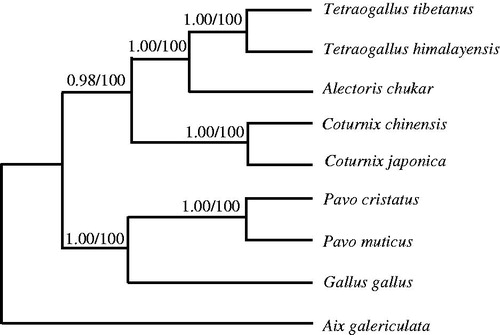Abstract
As the development of the new generation of sequencing (NGS) technologies, it has been used for standard sequencing applications more and more popular. We used NGS technologies to resequence the complete mitochondrial genome of Japanese quail. The complete mitochondrial genome of Japanese quail is a 16,668 bp circular molecule, which contains 37 typical mitochondrial genes (13 protein-coding genes, 2 rRNAs, and 22 tRNAs) and a 1156 bp D-loop. Its gene arrangement pattern is identical with typical other Galliformes. All protein-coding genes start with an ATG codon except COI, which start with GTG. TAA is the most frequent stop codon, although ND2 end with TAG, and COI and ND6 end with AGG, COIII and ND4 end with TGC. The mtDNA sequence contains 12S rRNA and 16S rRNA of rRNA. Except for tRNASer(AGY) and tRNALeu(CUN) without the dihydrouridine (DHU) arm, all tRNAs could be folded into canonical cloverleaf secondary structures. Coturnix japonica has close relative with C. chinensis.
The new generation of sequencing (NGS) technologies has provided unprecedented opportunities for high-throughput functional genomic research (Morozova & Marra Citation2008). Comparing to Sanger sequencing, NGS has been made in terms of speed, read length, and throughput, along with a sharp reduction in per-base cost, it has been more and more popular (Morozova & Marra Citation2008).
Japanese quail, Coturnix japonica belongs to the family Phasianidae and the order Galliformes, which breeds in eastern Asia, wintering in southern China and Southeast Asia. The Japanese quail is similar in appearance and has closely related to the Common quail, C. coturnix. Some authors think that these quail will interbreed and produce fertile hybrids (Harper Citation1986; Johnsgard Citation1988). In this study, we resequenced and characterized the complete mitochondrial genome used NGS technologies, and expected that it could provide more molecular data for the genetic studies of Japanese quail.
The blood sample of Japanese quail was acquired from the specimen storeroom of the laboratory in School of Life Science, Anhui Medical University (Sample codes are AMHU-AN20151023) and were stored at −80 °C. The blood sample was collected using non-invasive methods from a poultry farm in Nanjing City, no animal was killed for the purpose of the experiment. The mtDNA was sequenced by Sangon Biotech Co., Ltd. (Shanghai, China) using next-generation sequencing technology.
The length of the complete mtDNA sequence is 16,698 bp, is longer than the species which has been published in 2001 (accession no. AP003195, 16 697 bp in length) (Nishibori et al. Citation2001). Comparing to accession no. AP003195 sequence, 29 variable sites were observed, 11 sites were in the D-loop region, 16 sites were in the protein-coding gene (ND2, COI, COIII, ND3, ND4L, and Cyt b) regions, and two sites were in tRNA regions (tRNAAsp and tRNAGlu). The overall base composition for the mtDNA sequence is as follows: A, 31.1%, C, 31.3%, G, 13.1%, and T, 24.5%. A + T content (55.6%) is higher than C + G content (44.4%), similar to other aves species (Liu et al. Citation2013). The length of intergenic spacer sequences is 46 bp at 17 locations and the overlapping bases are 34 bp existing in 10 regions (). Among the the 13 PCGs, the longest one is ND5, and the shortest is ATP8, all protein-coding genes start with an ATG codon except for COI, which starts with GTG. TAA is the most frequent stop codon, although ND2 end with TAG, and COI and ND6 end with AGG, COIII and ND4 end with TGC (). The new mtDNA sequence contains 12S rRNA and 16S rRNA of rRNA, which are located between tRNAPhe and tRNALeu, separated by tRNAVal. The 12S rRNA is 974 bp long and the 16S rRNA is 1615 bp in length. All tRNA genes possess the typical clover leaf secondary structure except for tRNASer(AGN) and tRNALeu(CUN), which lacks a dihydroxyuridine (DHU) arm. The non-coding regions include a D-loop and a few intergenic spacers. The D-loop is located between tRNAPhe and tRNAGlu, and is 1156 bp long.
Phylogenetic trees were estimated using ML and BI methods, based on the complete mtDNA of eight Galliformes species, and corresponding Aix galericulata (KF437906) sequence was used as an outgroup, sharing similar topologies and high node support values (). Coturnix japonica has close relative with C. chinensis.
Table 1. Organization of the mitochondrial genome of Coturnix japonica.
Figure 1. Phylogenetic relationships among the eight Galliformes’ species based on complete mtDNA sequences. Numbers at each node are Bayesian posterior probabilities (left) and maximum likelihood bootstrap proportions (estimated from 100 pseudoreplicates) (right). The accession number in GenBank of eight Galliformes in this study: Gallus gallus (GU261698), Pavo muticus (EU417811), P. cristatus (KF444060), C. chinensis (AB073301), Alectoris chukar (FJ752426), Tetraogallus himalayensis (KR349185), T. tibetanus (KF027439).

Nucleotide sequence accession number
The complete mtDNA sequence of Japanese quail has been assigned with GenBank accession number KX712089.
Disclosure statement
The authors report no conflicts of interest. The authors alone are responsible for the content and writing of the paper.
Additional information
Funding
References
- Harper D. 1986. Pet birds for home and garden. London: Salamander Books Ltd.
- Johnsgard P. 1988. The quails, partridges, and francolins of the world. Oxford: Oxford University Press.
- Liu G, Zhou LZ, Zhang LL, Luo ZJ, Xu WB. 2013. The complete mitochondrial genome of Bean goose (Anser fabalis) and implications for Anseriformes taxonomy. PLoS One. 8:e63334.
- Morozova O, Marra MA. 2008. Applications of next-generation sequencing technologies in functional genomics. Genomics. 92: 255–264.
- Nishibori M, Hayashi T, Tsudzuki M, Yamamoto Y, Yasue H. 2001. Complete sequence of the Japanese quail (Coturnix japonica) mitochondrial genome and its genetic relationship with related species. Anim Genet. 32:380–385.
